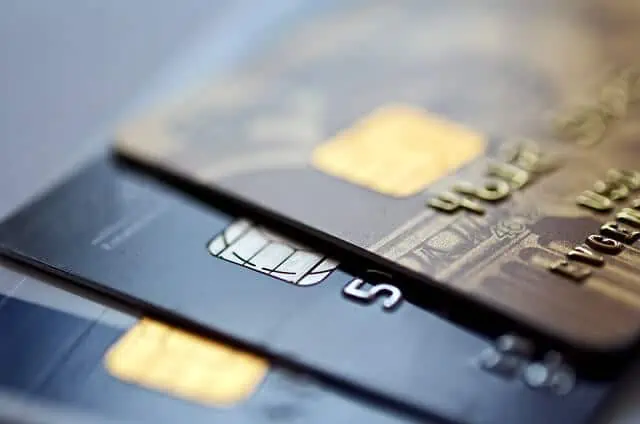When it comes to credit cards, cash back is one of the most popular features that people want. It’s not always easy to understand what cash back is and how it works though.
Some companies offer different tiers for special spending categories, cash back matching, cash back caps, cash back bonus incentives and more.
To untangle all the different components of cash back, we will talk about:
- what cash back means,
- how you can earn cash back rewards,
- why you should care about your credit card company’s offer for cash back and
- review some of the best cash back credit card options.
We’ll also talk about whether or not a cash back card is right for you based on your needs.
Let’s jump in!
Table of Contents
What is Cash Back?
When you get cash back from a credit card, it means you receive a percentage of your purchases back as a credit to use towards further expenses.
For example, if you spend $100 and get cash back at a rate of 5%, then you will be given $5 after paying for all your expenses with your card.
Rather than a flat rate, it’s popular for some credit card rewards program offerings to have different types of purchases carry different cash back percentages.
For example, you could get a 3% cash back rate at grocery stores and specific department stores while only getting 1% cash back for purchases at gas stations or restaurants.
We’ll go more into detail about bonus categories later.
Related: Best Credit Cards for Teenagers
How Do Cash Back Credit Cards Work?
Cash back cards work like any other card, except you can get cash back on your purchases. The credit may take several days or weeks before it shows up in your account depending on which credit card company you use.
Almost always, you’ll need to pay your bill first before receiving rewards on your cash back card.
Sometimes, your cash back is worth more if you redeem it for special offers through your card, such as travel expenses.
It’s popular for people to use different credit cards for various categories of purchases to make the most of cash back opportunities.
For instance, if one of your credit cards gives you 5% cash back for grocery store purchases, but only 1% cash back for everything else, you might use it just at the grocery store.
A different card in your wallet may give a 2% flat rate back on every purchase and be used for everything except grocery stores.
How Does Cash Back Redemption Work?
Depending on which credit card you’re using, your cash back redemption process can vary.
Some credit card issuers require you to have a minimum amount of cash back and pay your credit card bill before automatically depositing the money into your account, applying it as a statement credit or receiving it in a specified form.
For example, if your card gives you $25 or more in cash back at the end of each month, then that money will be added directly to your bank account once the total is reached and you’ve paid your bill. Some cards don’t have redemption minimums.
Below are some of the most common ways to receive cash back.
Statement Credits
One of the most common redemption methods for cash back credit cards is statement credits.
After you receive your statement and pay your bill, there will be a designated area on it where you can redeem your cash back bonus. By clicking this, you can reduce the amount on your next statement balance.
Direct Deposits into Your Bank Account
Some companies allow you to transfer your cash back into a designated bank account. If this is the case, it’s sometimes an option that only appears after reaching a minimum threshold for redemption.
For example, you might need to wait until you have $10 worth of cash back earned before transferring it your checking or savings account.
Depending on how frequently you make credit card purchases, you may be able to redeem money every month or may have to wait several months to earn enough.
Not all companies have a minimum. Some credit card companies will allow you to direct deposit your cash back no matter how little the amount.
Paper Checks
You may have the option to receive your cash back as a paper check.
In this case, you would need to wait for it to be mailed directly from the company and then deposit it into your bank account just like other checks.
If you choose this option, make sure your mailing address is up to date.
Travel Points
If you use your cash back credit card for travel expenses, then it’s likely the company offers a statement with several different types of redemption options.
For example, you could have enough points to book a flight or hotel room through their site and redeem them in one transaction. Usually, this is a better deal than the cash back option.
While you may have accumulated $1,000 in cash back, it might be worth $1,200, or more, in travel. Of course, that doesn’t necessarily mean the deals are your cheapest option if you want to travel on a budget.
Still, if they have flights and hotels available in a location on your bucket list, it’s definitely worth seeing if it can save you money.
Engaged couples will often put wedding expenses on a rewards credit card and then use the travel points earned to book a honeymoon.
Online Shopping
Credit card companies like to make deals with retailers. Sometimes, this includes offering cash back deals on select purchases—sometimes even in rotating categories.
Companies frequently offer extra points or a higher percentage of cash back for shopping through their site or even buying specific brands.
If your credit card company has a deal with a brand you shop frequently, it’s certainly worth it to use your card whenever you shop that brand.
Because these offers can change at any time through rotating categories or brands, you might want to check your card’s online portal or app regularly to see what they’ve added (or dropped) recently.
Sometimes you have to opt in for limited-time deals that earn extra cash back with specific brands.
Related: Best Debit Cards for Kids
Gift Cards
Gift cards are a popular option from cash back cards. Usually, the options you can choose from are pretty extensive and include major brands, such as Starbucks and Amazon.
Getting a gift card is a good option if you want to give somebody a present. You can also get one for yourself so you’re forced to treat yourself a bit if you tend to spend cash back solely on responsible purchases.
Transfers to Other Rewards Cards from the Same Issuing Bank
If you have more than one cash back credit card, or a similar rewards program from another bank or card issuer, it’s sometimes possible to transfer your points between them.
This is particularly common for travel cards and affiliated hotel chains. There may or may not be a minimum amount of money needed to transfer points.
Transferring isn’t always the best option because sometimes you lose some of the value when you transfer from one rewards card to another.
However, in a situation like the one above where you’re saving for free hotel stays or another travel reward, it can be useful.
Charitable Donations
Some companies allow you to donate your accumulated cash back points to charities.
If you’re trying to do some good and still earn rewards, this option is a great way to combine those goals. However, there is usually a transaction fee taken out.
The $100 you donate might end up being closer to $98 once it gets to the charity.
For small amounts, the difference is negligible and can still be a way to get you to donate more than you might otherwise.
But if you want to donate a significant amount to a charity, it may be wiser to get your cash back as a direct deposit and then use that money to donate directly to the charity of your choice.
Occasionally, credit cards will offer to match your donations to certain causes. When this is the situation, the match amount is likely higher than the fee (which might be waived altogether).
Related: Best Credit Cards for Students with No Credit
Do Cash Back Rewards on a Credit Card Expire?
Usually, cash back rewards on credit cards don’t expire as long as your account is open and in good standing.
If you plan to close an account, make sure to use points or your cash back within the available timeframe so you don’t lose them. This isn’t true for every credit card.
For some, your points might expire even if you keep your account open, so check the policy of any card you are considering.
You might need to take them as a statement credit, voucher, coupon, check, rewards transfer or other form of payment on a regular basis to keep them from expiring.
How Can Cash Back Credit Cards Affect Your Spending Habits?
For some people, cash back cards can create a cycle where you spend more money than you otherwise would, creating bad spending habits.
Don’t let cash rewards trick you into overspending on products and services you might not need.
Consider cash back from credit cards as a bonus for the shopping you already do rather than an incentive to buy products you otherwise wouldn’t. Seen in reverse and you might earn cash but only at the expense of paying more overall—and on things you don’t necessarily need.
For example, a cash back rewards card may incentivize you to shop at certain stores over others. This can be by design and not inherently bad in any way. Further, it can be financially smart.
However, if you didn’t plan to shop at a store to begin with, shopping there solely to get a higher cash back rate backfires when incorporated within your entire personal finance picture.
Though, when a store or brand you like becomes a bonus category, this might be a good time to earn money on every purchase made there, redeem your cash back and use the money to add flexibility in your budget.
In fact, doing this can get you more rewards for products you purchase in specific listing categories you intended to buy already.
If you have the discipline to control your spending, taking advantage of certain stores or promotions in a bonus category to buy products can earn money for your intended actions.
Related: Joint Credit Cards: Can They Be a Good Way to Build Credit?
Can You Earn Cash Back Rewards as an Authorized User?
Authorized users can usually help towards earning cash back rewards with their purchases. This is an excellent way for people with family members who shop frequently or travel often to take advantage of extra points without having their own account.
Whether authorized users can redeem those rewards back in the form of cash, statement credits or other method is often up to the primary cardholder.
To allow an authorized user to redeem cash back, they typically have to call their credit card company. Sometimes this setting can be changed within an app.
However, not all credit card companies allow authorized users to redeem rewards. With some cards, the cash back is only for the main card holder as authorized user status doesn’t equate to having financial liability for the accounts.
Related:
- What is Credit Card Piggybacking & Does it Help Credit Scores?
- 5 Ways to Build Credit as a College Student: What to Know
What are Flat Rate Cards vs. Bonus Category Cash Back Cards?
Flat rate credit cards tend to give you a consistent amount in points or cash back that is always the same no matter in which spending categories consumers make a purchase. For example, you might receive 2% cash back on all purchases.
Bonus category cash back cards offer more rewards in certain stores, like gas stations or grocery stores.
You may have a breakdown where you get 3% back on purchases at gas stations, 2% cash back on purchases at grocery stores, and 1% cash back on purchases everywhere else, or something similar. For some cards, the bonus categories stay the same all year.
For other cards, the bonus categories rotate. For instance, consumers might get 5% back on just grocery store purchases from January to April and then 5% back at just restaurants from May to August.
Meanwhile, other purchases would still provide a small amount of cash back.
If you have bonus categories cash back cards, make sure to pay attention to what you currently get more cash back for, especially if you have several rewards programs card options you rotate between depending on the type of purchase.
When Do You Receive Your Cash Back from Credit Card Companies?
The time it takes to receive cash back on credit cards can vary. For some, your rewards come every month after you’ve paid your last statement balance. For others, you receive a check in the mail every quarter.
Check with your credit card company to find out what their policy is on cash back rewards and when they send them out.
You may have to manually go in and redeem you cash back in the way you want it, such as by applying credit to your next statement, direct deposit to your bank account, or towards travel.
Each cash back rewards program varies, and redeeming rewards may require some navigation on your part.
What are the Best Cash Back Cards to Consider?
Petal® 2 “Cash Back, No Fees” Visa® Credit Card
The Petal® 2 “Cash Back, No Fees” Visa® starter credit card wants to take to heart people’s thoughts on it being time for a card company to help people succeed financially.
To heed this call, Petal® has used modern technology to design credit card products that help you budget, control your spending, and build credit.
This card is best for those with thin to no credit files because Petal® accepts applicants based on cash flow underwriting alone—meaning no credit history is required.
And if you have a credit score, you can get the opportunity for acceptance with a fair credit rating, meaning you need a minimum credit score of 600 or better. If you have a credit score of 720 or better, Petal® auto-approves your application.
This credit card issuer reports your payment history to all 3 major credit bureaus, helping you build credit.
The Petal® 2 card offers 2% – 10% cash back at select merchants and up to 1.5% cash back on eligible purchases after making 12 on-time monthly payments.
With the alternative means for evaluating applicants’ eligibility, Petal® 2 might be an excellent choice to consider as a beginner cash back credit card.
This credit card charges no fees whatsoever, letting you avoid simply holding the card in your wallet.
- No annual fee–in fact, no fees of any kind
- Up to 1.5% cash back on unlimited everyday purchases (1% right away increases to 1.25% after 6 monthly on time payments and 1.5% after another 6 monthly on time payments)
- 2-10% cash back at select local and national merchants
- See if you’re pre-approved in minutes without impacting your credit score
- No credit score? No problem. Credit history isn’t required for approval
- Get an automatic credit limit increase after 6 qualifying on time monthly payments. Terms apply
- Build credit alongside hundreds of thousands of Petal card members
- Petal reports to all 3 major credit bureaus
- Pay with ease with a contactless card or on your phone using Apple Pay, Google Pay, or Samsung Pay
- Zero liability fraud coverage
- No security deposit required
- Card issued by WebBank
- Cash back on everyday purchases, as well as potential for extremely high cash back with select merchants
- No fees whatsoever
- Minimum credit score for consideration is higher than Petal® 1.
Related: Best Credit Cards for No Credit History: Starter Credit Cards
Petal® 1 “No Annual Fee” Visa® Credit Card
Like the first Petal® starter credit card above, this alternative uses modern technology to design credit card products that help you budget, control your spending, and build credit.
The Petal® 1 “No Annual Fee” Visa® card is also best for those with thin to no credit files because Petal accepts applicants based on Cash Flow underwriting alone.
And if you have a credit score, you can get the opportunity for acceptance with a low to a fair credit rating of 550 or better. If you have a credit score of 720 or better, Petal® auto-approves your application.
The Petal® 1 card offers up to 1.5% cash back on eligible purchases after making 12 on-time monthly payments, 1% cash back on eligible purchases right away and 2% – 10% cash back at select merchants.
- No annual fee, and no security deposit required
- 2-10% cash back at select local and national merchants
- See if you’re pre-approved in minutes without impacting your credit score
- No credit score? No problem. Credit history isn’t required for approval
- Get an automatic credit limit increase after 6 qualifying on time monthly payments. Terms apply
- Build credit alongside hundreds of thousands of Petal card members
- Petal reports to all 3 major credit bureaus
- Pay with ease with a contactless card or on your phone using Apple Pay, Google Pay, or Samsung Pay
- Zero liability fraud coverage
- Card issued by WebBank
- No annual or foreign transaction fees
- Potential for extremely high cash back with select merchants
- No everyday cash-back feature
- Cardholders are subject to late and returned payment fees
- Higher APRs and lower max credit limit than Petal® 2.
Related: How Parents Can Help Their Children Start to Build Credit
Aspiration Spend & Save™
Aspiration offers socially-conscious and sustainable ways to spend and save. And, unlike the big banks, Aspiration doesn’t use consumers’ deposits to fund oil pipelines.
Shop with purpose, get cash back. Swipe your card, plant a tree. Earn up to 5.00% APY. Unlimited fee-free ATM withdrawals at Allpoint ATMs.
- Earn cash back on debit card purchases and up to 83x the national interest rate on savings
- Choose a monthly fee you think is fair
- Aspiration Spend and Save account does not include a credit card
- Spend and save with fossil fuel-free deposits
- Fee-free ATM withdrawals at 55,000+ Allpoint ATMs
- Cash back on debit card purchases at socially conscious businesses
- Up to 5.00% in interest on savings with Aspiration Plus
- Option to plant a tree with every roundup
- Personal impact score to help you shop to match your values
Related:
- Best Prepaid Debit Cards for Teens & Families [Reloadable]
- Best Free Debit Cards for Kids & Teens [Earn, Spend & Save]
Should You Get a Cash Back Debit Card?
You don’t just need to consider cash back credit card options. As an alternative, you might also consider a cash back debit card.
While these debit cards won’t help with your credit scores, they can still help you to earn some bonus cash on your everyday purchases.
These can offer a percentage of cash back on your purchases, whether as a flat percentage or even as bonus cash back on top of this for specific spending categories.
Further, they also allow you to avoid using a credit card if you don’t feel comfortable using a line of credit from a credit card issuer and instead only want to spend money you hold in bank accounts.
Banks understand they need to remain competitive with their own rewards programs or cash rewards products if they don’t have a credit card offering.
They will want someone currently banking with them or considering banking with them to participate in their programs and banking ecosystem.
Be sure you understand all the rules involved for earning reward points, cashback, or anything else required of debit cardholders.
Likewise, with cash back rewards credit cards, understand not only the rewards program rules rules but also the control necessary to manage your money wisely.
Related:
- Best Credit Cards for Kids: Building Credit & Money Habits Early
- Best Debit Cards for Teens [Rated + Reviewed by a Father]
Should You Get a Cash Back Credit Card?
Cash back credit cards are a great incentive for people who spend money on credit. You can use them to earn bonus cash or to help pay off your monthly credit card bill.
If you’re spending money anyway, you might as well get some of it back—whether as a flat rate or a higher percentage on a purchase bonus category.
Before you apply, make sure the rewards outweigh any fees associated with those cash back options and that they fit within what you normally buy.
While some cards have no annual fees, other rewards cards may have a high annual fee that isn’t worth it for light spenders.
If you can handle credit cards, going for a cash back card or rewards card makes complete sense because they not only pay you in rewards, but they also offer other useful benefits long-term.
Overall, cash back credit cards provide the same benefits as other credit cards, such as convenience and building credit, but with an extra bonus. For most credit card users, it makes sense to go with a cash back reward credit card.




















